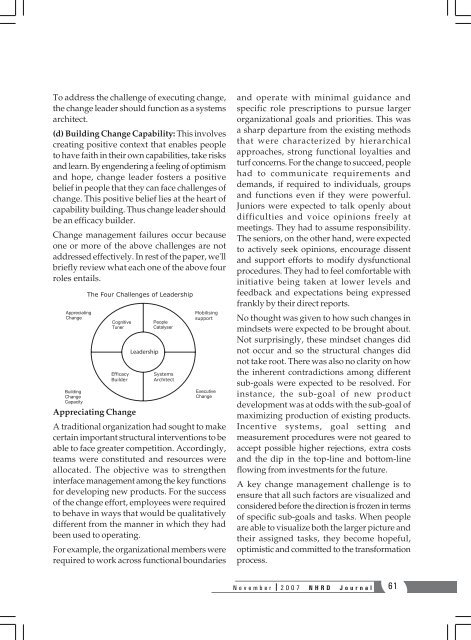NHRD Journal - National HRD Network
NHRD Journal - National HRD Network
NHRD Journal - National HRD Network
You also want an ePaper? Increase the reach of your titles
YUMPU automatically turns print PDFs into web optimized ePapers that Google loves.
To address the challenge of executing change,<br />
the change leader should function as a systems<br />
architect.<br />
(d) Building Change Capability: This involves<br />
creating positive context that enables people<br />
to have faith in their own capabilities, take risks<br />
and learn. By engendering a feeling of optimism<br />
and hope, change leader fosters a positive<br />
belief in people that they can face challenges of<br />
change. This positive belief lies at the heart of<br />
capability building. Thus change leader should<br />
be an efficacy builder.<br />
Change management failures occur because<br />
one or more of the above challenges are not<br />
addressed effectively. In rest of the paper, we'll<br />
briefly review what each one of the above four<br />
roles entails.<br />
Leadership<br />
Appreciating Change<br />
A traditional organization had sought to make<br />
certain important structural interventions to be<br />
able to face greater competition. Accordingly,<br />
teams were constituted and resources were<br />
allocated. The objective was to strengthen<br />
interface management among the key functions<br />
for developing new products. For the success<br />
of the change effort, employees were required<br />
to behave in ways that would be qualitatively<br />
different from the manner in which they had<br />
been used to operating.<br />
For example, the organizational members were<br />
required to work across functional boundaries<br />
and operate with minimal guidance and<br />
specific role prescriptions to pursue larger<br />
organizational goals and priorities. This was<br />
a sharp departure from the existing methods<br />
that were characterized by hierarchical<br />
approaches, strong functional loyalties and<br />
turf concerns. For the change to succeed, people<br />
had to communicate requirements and<br />
demands, if required to individuals, groups<br />
and functions even if they were powerful.<br />
Juniors were expected to talk openly about<br />
difficulties and voice opinions freely at<br />
meetings. They had to assume responsibility.<br />
The seniors, on the other hand, were expected<br />
to actively seek opinions, encourage dissent<br />
and support efforts to modify dysfunctional<br />
procedures. They had to feel comfortable with<br />
initiative being taken at lower levels and<br />
feedback and expectations being expressed<br />
frankly by their direct reports.<br />
No thought was given to how such changes in<br />
mindsets were expected to be brought about.<br />
Not surprisingly, these mindset changes did<br />
not occur and so the structural changes did<br />
not take root. There was also no clarity on how<br />
the inherent contradictions among different<br />
sub-goals were expected to be resolved. For<br />
instance, the sub-goal of new product<br />
development was at odds with the sub-goal of<br />
maximizing production of existing products.<br />
Incentive systems, goal setting and<br />
measurement procedures were not geared to<br />
accept possible higher rejections, extra costs<br />
and the dip in the top-line and bottom-line<br />
flowing from investments for the future.<br />
A key change management challenge is to<br />
ensure that all such factors are visualized and<br />
considered before the direction is frozen in terms<br />
of specific sub-goals and tasks. When people<br />
are able to visualize both the larger picture and<br />
their assigned tasks, they become hopeful,<br />
optimistic and committed to the transformation<br />
process.<br />
November 2007 <strong>N<strong>HRD</strong></strong> <strong>Journal</strong> 61
















